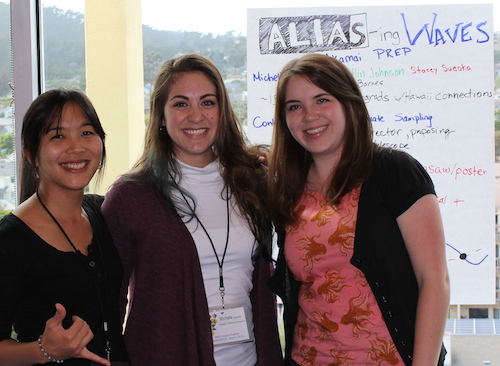Designing Optical Detectors using Principles of Adequate Sampling, and Defining Requirements.
Activity Name: Akamai Signals
Team:
Austin Barnes (team leader): ISEE/University of California, Santa Cruz.
Michelle Consiglio: University of California, Los Angeles. Graduate Student, Astronomy and Astrophysics.
Caitlin Johnson: University of California, Santa Cruz. Graduate Student, Physics.
Stacey Sueoka: National Solar Observatory, Optical Systems Engineer.
Audience:
30 undergraduates just beginning a 7 week summer internship at multiple technology and astronomy organizations in the Hawaiian Islands.
Venue:
Akamai PREP course: 4 day preparatory course held at the University of Hawaii Hilo campus.
Activity Summary:
The Akamai Signals activity was taught during the 2016 Akamai PREP course, which is a 4-day intensive course that geared the 30 Akamai undergraduate interns in various STEM fields up for their 7-week internship. Students used principles of adequate sampling to define the spatial sampling rate and design an optical detector that accomplished their proposed goal. This concept is fundamental to signals and signal processing in engineering but is also at the heart of instrumentation that converts analog (continuous) signals into digital signals. Mastery of this concept gives learners insight into the common but not well understood general rules used to determine frequencies of frames in film and phenomena like aliasing, while also helping to develop a learner’s identity as an engineer. This concept is core to engineering, particularly electrical engineering.
Learners also engaged in the practice of “defining requirements” to translate science goals identified for a particular scene into requirements that a detector design must meet in order to achieve that goal. We have found in Akamai and from surveys of our mentors that “defining requirements” is a fundamental practice in engineering that needs to be done before a project is undertaken. Defining what the solution MUST do guides the entire engineering design and is a crucial step acting as a link between the science goal of a project (the motivation behind the entire project) and the design specifications, the details of the actual design. If requirements are not defined, the design will not meet the science goal or will be over-designed in a way that is excessive and often costly.
Learners were presented with six different scenes, some astronomical, some biological, and others related to Hawaii. The different scenes were meant to present a wide variety of scenarios that could be imaged but also to engage students with different backgrounds and interests. The scenes prompted learners to ask questions of the type “how could our imaging system…” related to the scene. This would lead the learners to develop science goals of that type and explore how to design a detector to accomplish that goal by engaging in the practice of defining requirements. During investigations, teams could choose their goal related to the scene of their choice and had a great deal of choice and challenge around defining the requirements of the imaging system needed to accomplish that goal. Facilitators helped to guide learners through this process and give feedback while they iterated.
The culminating assessment task was a jigsaw design review, meaning each member of the investigation teams was split off from the rest of the group and presented their work to a panel of peers and a facilitator that were reviewing their design, given the prompts:
1. What was the goal you defined based on your image?
2. What key feature in the image helps you meet that goal?
3. What size were your pixels, and what determined that value?
This helped learners talk about their designs but come to a shared understanding of adequate sampling and how pixel size is determined by the key feature and a general rule of approximately 2 pixels per key feature.
From the learners, we collected Design Review worksheets after the jigsaw for individual assessment. Two points maximum could be awarded for each of the three knowledge statements on our rubric. In one of the design review jigsaw groups, four of the ten learners scored a six out of six, and several were within a point or two from a full score, displaying a sufficient understanding of at least two of the three rubric dimensions. We also had learners who were unable to be assessed in a rubric dimension due to lack of evidence to assess it. Overall, the majority of the students scored well and demonstrated an understanding of adequate sampling.
While we did not score the learners on the practice of defining requirements, we used probing questions throughout the activity and in the CAT to help us gauge their proficiency in it. During their investigations and in the CAT, we asked the learners about their reasoning for choosing a particular pixel size and how their choice affected limitations in their detector for answering their particular question. As a group, the learners did an excellent job of identifying the question driving detector requirements, identifying what a solution must do in a verifiable way, and distinguishing between requirements and constraints, which are all aspects of defining requirements.
Funding:
Funding for this team was provided by:
NSF #AST1347767 (PI: L. Hunter, NSF #AST1412851 (PI: C. Max), Thirty Meter Telescope National Observatory, and Daniel K. Inouye Solar Telescope

